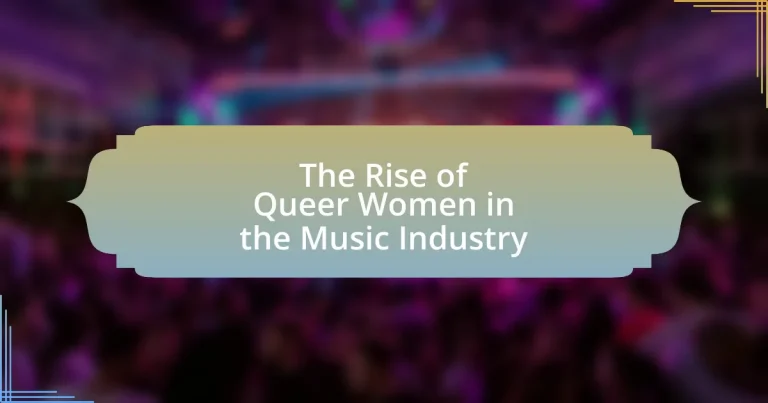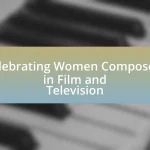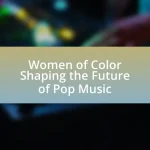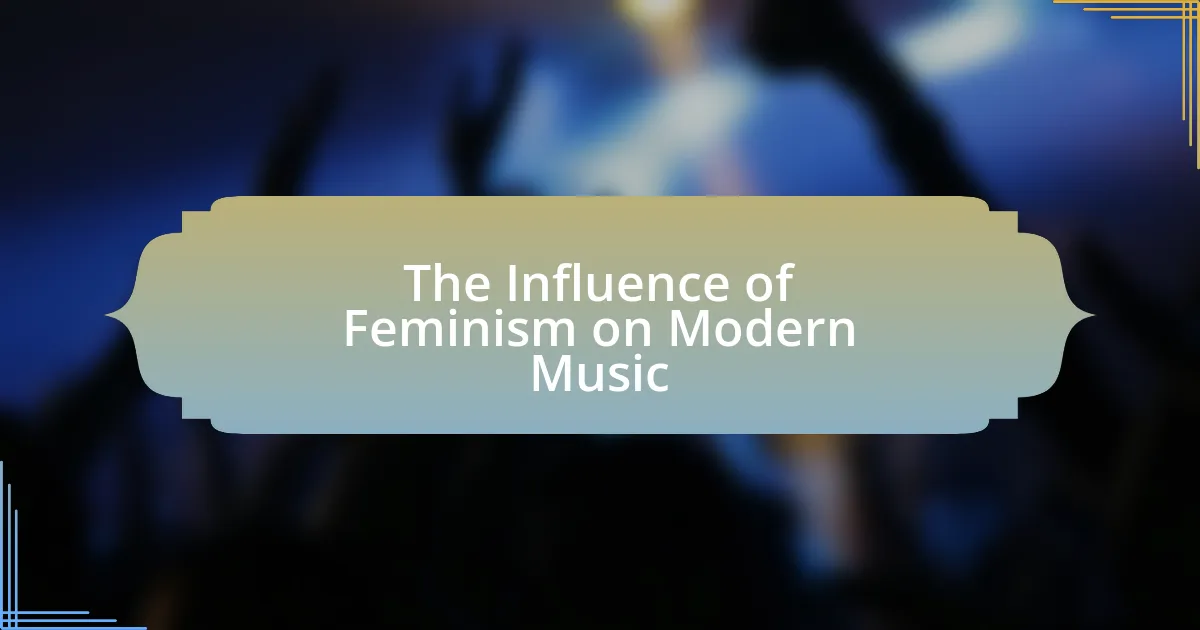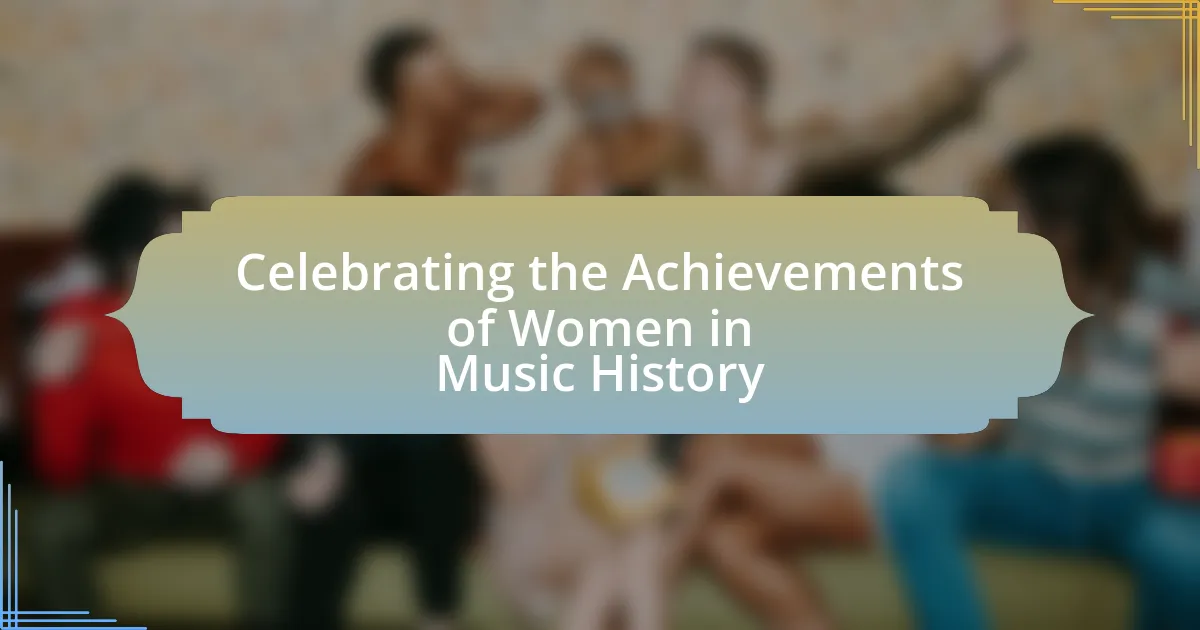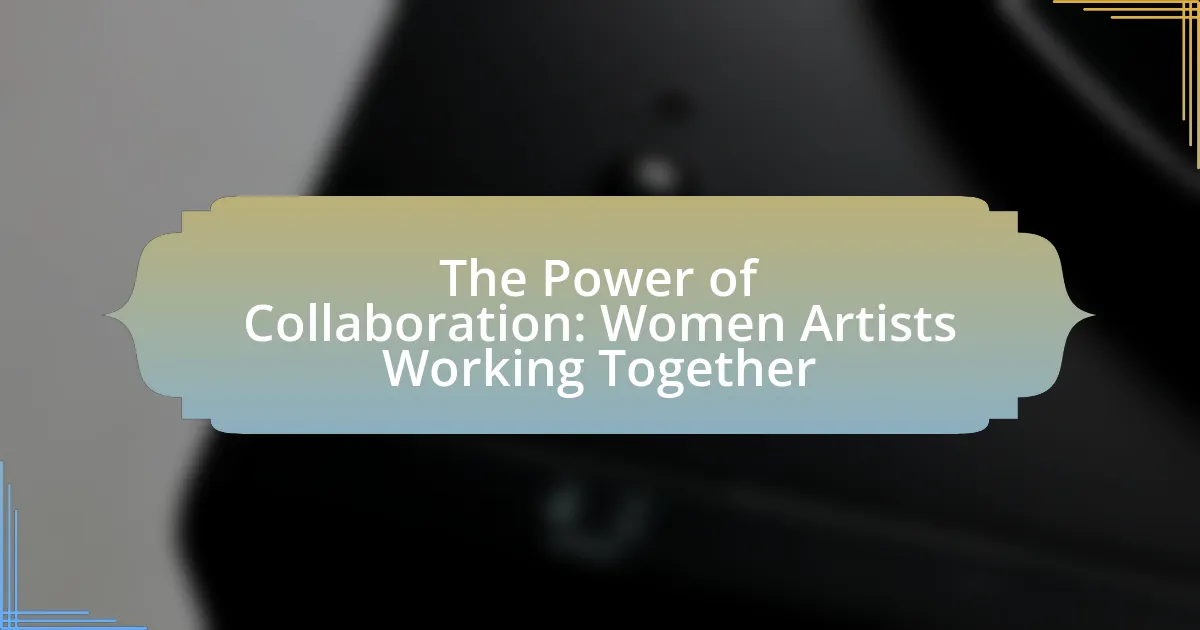The article examines the rise of queer women in the music industry, highlighting key factors such as increased visibility, evolving societal attitudes, and supportive platforms that have contributed to their prominence. It discusses how societal acceptance has enhanced visibility, allowing queer women to express their identities and gain recognition across various genres. The article also addresses the challenges faced by queer women, including discrimination and underrepresentation, while showcasing their significant contributions to music trends and styles. Additionally, it explores the impact of collaborations among queer women artists and outlines future prospects for their success in the industry, emphasizing the importance of community support and resources available to aspiring musicians.
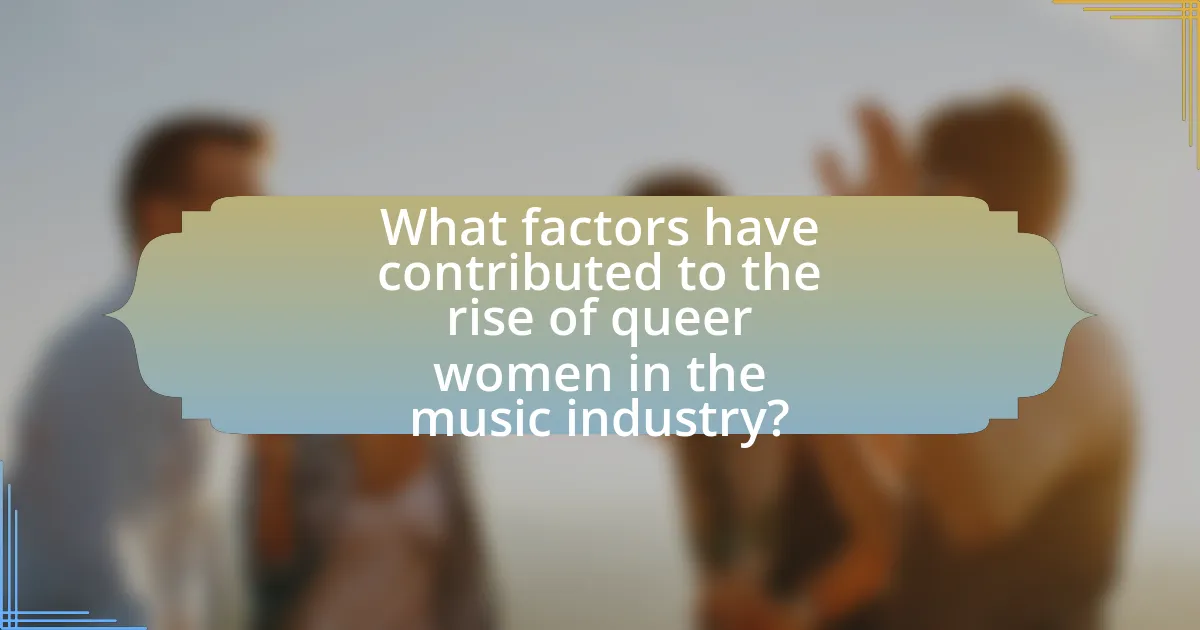
What factors have contributed to the rise of queer women in the music industry?
The rise of queer women in the music industry has been significantly influenced by increased visibility and representation, evolving societal attitudes, and the emergence of supportive platforms. Increased visibility has allowed queer women to express their identities openly, leading to a greater acceptance within the industry. Evolving societal attitudes, particularly in the last two decades, have fostered a more inclusive environment, encouraging artists to embrace their sexual orientation without fear of backlash. Additionally, platforms such as social media have provided queer women with tools to reach audiences directly, bypassing traditional gatekeepers and enabling them to build their own fan bases. These factors collectively contribute to the growing prominence of queer women in music, as evidenced by the success of artists like Hayley Kiyoko and Janelle Monáe, who have openly celebrated their identities and achieved commercial success.
How has societal acceptance influenced queer women’s visibility in music?
Societal acceptance has significantly enhanced queer women’s visibility in music by creating an environment where they can express their identities openly. As acceptance has grown, particularly since the late 20th century, more queer women have emerged as prominent artists, contributing to a diverse range of genres. For instance, artists like Melissa Etheridge and Tegan and Sara have gained mainstream recognition, reflecting a shift in public perception and media representation. This visibility is further supported by events such as Pride celebrations and LGBTQ+ music festivals, which provide platforms for queer women to showcase their talents. Research indicates that increased representation in media correlates with greater societal acceptance, reinforcing the idea that visibility leads to normalization and acceptance of queer identities in the music industry.
What role do cultural movements play in promoting queer women artists?
Cultural movements play a crucial role in promoting queer women artists by providing visibility, community support, and platforms for expression. These movements, such as the LGBTQ+ rights movement and feminist art movements, have historically challenged societal norms and created spaces where queer women can share their experiences and artistry. For instance, events like Pride festivals and initiatives like the Queer Women of Color Media Arts Project have specifically highlighted the contributions of queer women in the arts, fostering an environment that encourages their creative output. Additionally, the rise of social media has amplified these efforts, allowing queer women artists to reach wider audiences and connect with like-minded individuals, further solidifying their presence in the music industry.
How have changes in media representation impacted queer women’s careers?
Changes in media representation have positively impacted queer women’s careers by increasing visibility and acceptance within the music industry. As more queer women are portrayed in diverse and authentic roles across various media platforms, they gain greater opportunities for recognition and success. For instance, the rise of artists like Hayley Kiyoko and Lil Nas X has not only challenged stereotypes but also demonstrated the commercial viability of queer representation, leading to increased support from record labels and media outlets. This shift has resulted in a more inclusive environment, allowing queer women to pursue careers with less stigma and more support, ultimately contributing to their growth and influence in the industry.
What challenges have queer women faced in the music industry?
Queer women in the music industry have faced significant challenges, including discrimination, lack of representation, and barriers to mainstream success. Discrimination manifests in various forms, such as bias from industry gatekeepers and audiences, which can hinder their opportunities for visibility and acceptance. Additionally, the underrepresentation of queer women in music genres and leadership roles limits their influence and access to resources. A study by the USC Annenberg Inclusion Initiative found that only 2.1% of artists in popular music were women from the LGBTQ+ community, highlighting the systemic barriers they encounter. These challenges contribute to a difficult environment for queer women striving for recognition and success in the music industry.
How do discrimination and bias affect queer women musicians?
Discrimination and bias significantly hinder the opportunities and recognition of queer women musicians. These musicians often face systemic barriers, including limited access to funding, fewer performance opportunities, and challenges in gaining media visibility compared to their heterosexual counterparts. For instance, a study by the University of Southern California’s Annenberg Inclusion Initiative found that LGBTQ+ artists are underrepresented in mainstream music, with only 2.1% of artists in the top charts identifying as queer. This lack of representation can lead to a cycle where queer women musicians struggle to find platforms to showcase their work, ultimately affecting their career growth and visibility in the industry.
What barriers exist for queer women in gaining mainstream recognition?
Queer women face several barriers in gaining mainstream recognition, including societal stigma, lack of representation, and industry biases. Societal stigma often leads to discrimination and marginalization, making it difficult for queer women to find platforms that support their work. Additionally, the music industry has historically favored heterosexual narratives, resulting in limited visibility for queer artists. A study by the USC Annenberg Inclusion Initiative found that only 22.5% of artists in popular music were women, and even fewer identified as queer, highlighting the significant underrepresentation. These factors collectively hinder queer women’s opportunities for recognition and success in the mainstream music industry.
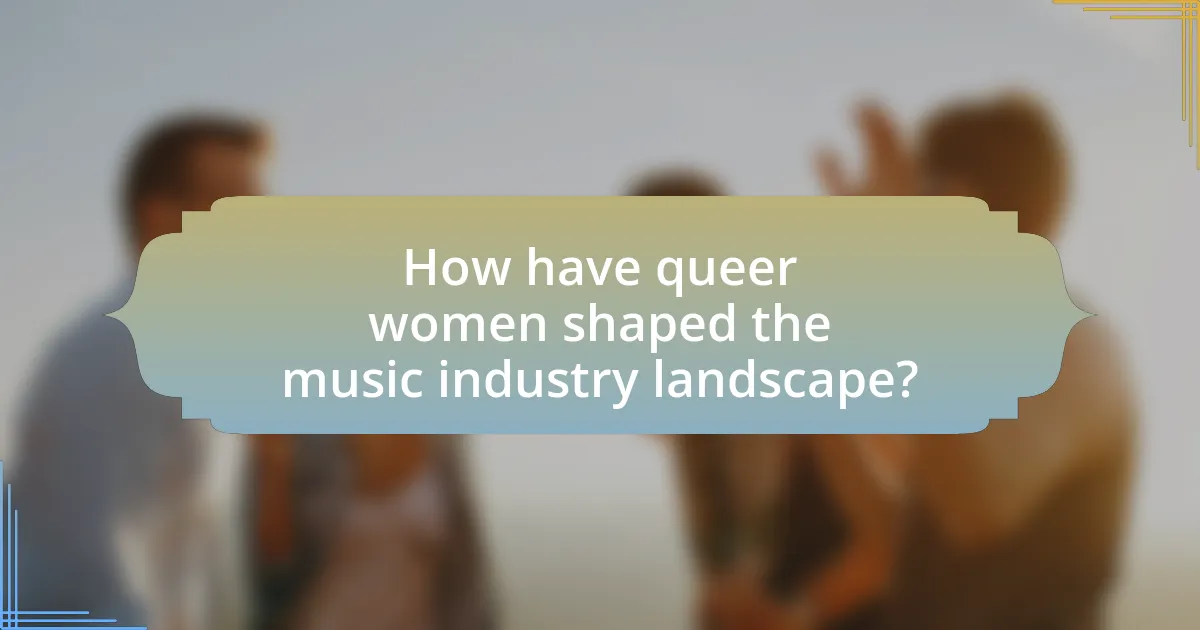
How have queer women shaped the music industry landscape?
Queer women have significantly shaped the music industry landscape by challenging norms, influencing genres, and advocating for representation. Artists like Melissa Etheridge and Tegan and Sara have not only achieved commercial success but have also used their platforms to promote LGBTQ+ visibility and rights. Their contributions have led to a broader acceptance of diverse identities within mainstream music, as evidenced by the increasing number of queer artists in various genres, from pop to indie. Furthermore, queer women have played pivotal roles in the creation of music festivals and organizations that celebrate LGBTQ+ culture, such as the Dinah Shore Weekend and the Queer Music Festival, fostering community and support within the industry.
What genres have seen significant contributions from queer women artists?
Queer women artists have made significant contributions to genres such as pop, rock, folk, and hip-hop. In pop music, artists like Hayley Kiyoko and Janelle Monáe have gained recognition for their queer representation and themes. In rock, artists like Melissa Etheridge and Tegan and Sara have influenced the genre with their music and activism. Folk music has seen contributions from artists like Brandi Carlile, who openly discusses her sexuality in her work. In hip-hop, artists like Lil Nas X and Mykki Blanco have challenged norms and brought queer narratives to the forefront. These contributions have not only enriched the genres but also fostered greater visibility and acceptance within the music industry.
How do queer women artists innovate within their musical genres?
Queer women artists innovate within their musical genres by incorporating diverse influences, challenging traditional norms, and expressing unique narratives. For instance, artists like Janelle Monáe blend genres such as funk, soul, and pop while addressing themes of identity and sexuality in their lyrics, which expands the boundaries of conventional music. Additionally, queer women often utilize their platforms to advocate for social change, as seen in the work of artists like Hayley Kiyoko, who openly discusses LGBTQ+ experiences in her music, thereby fostering inclusivity and representation. This innovation is further evidenced by the rise of genre-blending and experimental sounds in the works of queer women, which disrupts the status quo and encourages a broader acceptance of varied musical expressions.
What impact do queer women have on music trends and styles?
Queer women significantly influence music trends and styles by introducing diverse perspectives and innovative sounds. Their contributions often challenge traditional norms, leading to the emergence of new genres and subcultures. For instance, artists like Lil Nas X and Hayley Kiyoko have popularized themes of LGBTQ+ identity in mainstream music, reshaping the narrative around sexuality and representation. Additionally, queer women have been pivotal in the rise of genres such as indie pop and electronic music, where their unique experiences and artistic expressions resonate with broader audiences. This impact is evidenced by the increasing visibility of queer women in music charts and festivals, reflecting a shift towards inclusivity and diversity in the industry.
How do collaborations among queer women artists influence the industry?
Collaborations among queer women artists significantly influence the music industry by fostering inclusivity and challenging traditional norms. These partnerships often lead to innovative sounds and artistic expressions that resonate with diverse audiences, thereby expanding market reach. For instance, collaborations like those between artists such as Hayley Kiyoko and Kehlani have not only garnered critical acclaim but also increased visibility for queer narratives in mainstream media. This visibility is supported by data showing that LGBTQ+ representation in music has grown, with a 2021 report from GLAAD indicating that 22% of charting artists identified as LGBTQ+, up from 14% in 2018. Such collaborations not only empower the artists involved but also encourage industry stakeholders to embrace a broader spectrum of talent, ultimately reshaping the landscape of the music industry.
What are some notable collaborations that have emerged in recent years?
Notable collaborations that have emerged in recent years include the partnership between Brandi Carlile and Maren Morris on the song “Common,” which highlights themes of unity and empowerment. Additionally, the collaboration between Hayley Kiyoko and Kehlani on “What I Need” showcases queer representation in mainstream music. These collaborations not only amplify the voices of queer women but also contribute to a broader acceptance and visibility within the industry.
How do these collaborations challenge traditional music industry norms?
Collaborations among queer women in the music industry challenge traditional norms by promoting inclusivity and diversity, which disrupts the conventional male-dominated landscape. These partnerships often blend various genres and styles, showcasing a broader range of artistic expression that defies the rigid categorization typically seen in mainstream music. For instance, the collaboration between artists like Hayley Kiyoko and Kehlani not only highlights their unique identities but also attracts a diverse audience, thereby expanding market reach and challenging the industry’s focus on heteronormative narratives. This shift is evidenced by increased visibility and commercial success of queer artists, as seen in the rise of streaming numbers and chart placements for songs that embrace LGBTQ+ themes.
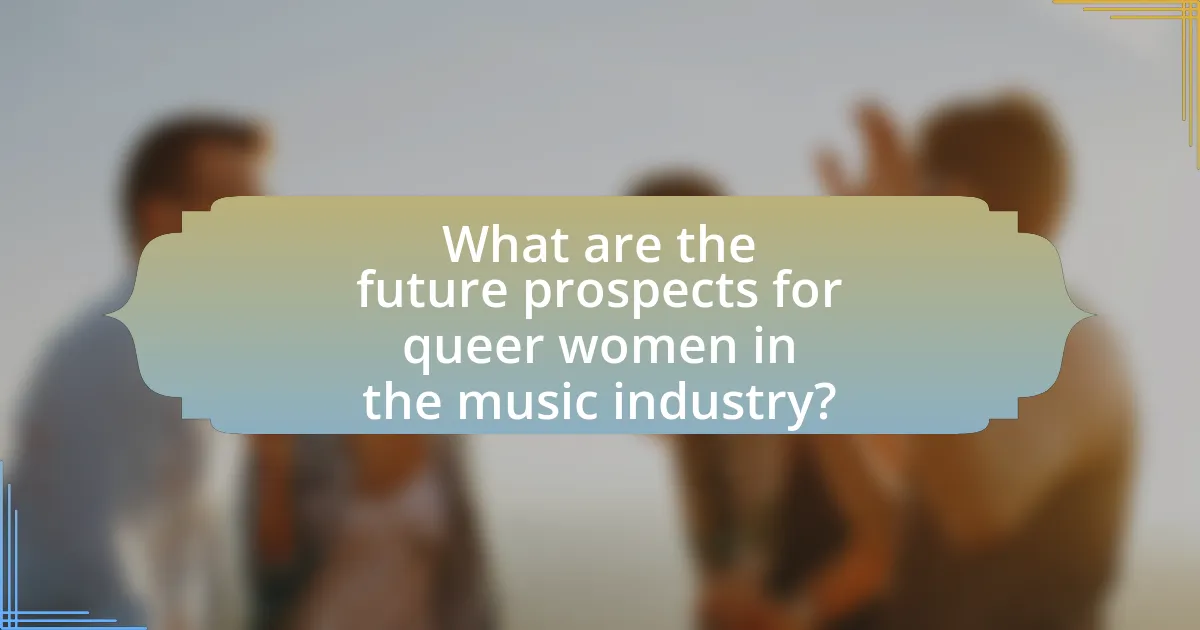
What are the future prospects for queer women in the music industry?
The future prospects for queer women in the music industry are increasingly positive, driven by growing visibility and acceptance. As of 2023, queer women are gaining more representation in mainstream music, with artists like Lil Nas X and Hayley Kiyoko leading the charge, which has opened doors for others. The increase in LGBTQ+ music festivals and events, such as Pride celebrations, further supports this trend by providing platforms for queer women to showcase their talent. Additionally, data from the 2021 Music Industry Report indicates that 50% of music executives believe diversity in the industry is essential for success, suggesting that queer women will continue to find opportunities for advancement and recognition.
How can the music industry continue to support queer women artists?
The music industry can continue to support queer women artists by increasing visibility and representation in mainstream media and music festivals. Research shows that diverse lineups at festivals, such as the 2019 Coachella, which featured a higher percentage of female artists, positively impacts audience perceptions and acceptance of underrepresented groups. Additionally, record labels can prioritize signing and promoting queer women artists, as evidenced by the success of artists like Hayley Kiyoko and Janelle Monáe, who have gained significant traction and visibility. Furthermore, creating mentorship programs that connect established queer women artists with emerging talent can foster community and growth within the industry.
What initiatives are being implemented to promote diversity in music?
Initiatives promoting diversity in music include programs like the “Women in Music” organization, which advocates for gender equality and provides resources for women in the industry. Additionally, initiatives such as the “Queer Music Heritage” project aim to document and celebrate LGBTQ+ contributions to music, fostering inclusivity. Research from the “Institute for Music Leadership” highlights that diverse representation in music not only enriches the industry but also reflects broader societal changes, emphasizing the importance of these initiatives in creating a more equitable music landscape.
How can audiences contribute to the success of queer women in music?
Audiences can contribute to the success of queer women in music by actively supporting their work through streaming, purchasing music, attending live performances, and promoting their art on social media. This support translates into increased visibility and financial stability, which are crucial for artists’ careers. For instance, a study by the University of Southern California’s Annenberg Inclusion Initiative found that increased audience engagement directly correlates with higher chart performance and greater opportunities for artists. By creating a demand for queer women’s music, audiences help dismantle barriers and foster a more inclusive music industry.
What practical steps can aspiring queer women musicians take to succeed?
Aspiring queer women musicians can succeed by actively networking within the LGBTQ+ community and seeking mentorship from established artists. Building connections through platforms like social media, attending LGBTQ+ music festivals, and participating in community events can enhance visibility and opportunities. Research indicates that mentorship significantly increases the likelihood of success in creative fields; for instance, a study by the National Endowment for the Arts found that artists with mentors are more likely to achieve professional milestones. Additionally, honing musical skills through consistent practice and seeking feedback from peers can improve artistry and performance. Engaging with online music platforms and utilizing digital distribution channels can also broaden reach and audience engagement, as evidenced by the rise of independent artists leveraging platforms like Bandcamp and SoundCloud to gain recognition.
What resources are available for queer women entering the music industry?
Queer women entering the music industry can access various resources, including organizations, mentorship programs, and funding opportunities. Notable organizations such as the LGBTQ+ advocacy group GLAAD provide support and resources tailored for queer artists. Additionally, initiatives like the “Women in Music” organization offer mentorship and networking opportunities specifically for women, including those from the queer community. Funding opportunities are also available through grants from organizations like the Queer Arts Festival, which supports queer artists in various disciplines, including music. These resources collectively aim to empower queer women and facilitate their entry and success in the music industry.
How can networking and community support enhance their careers?
Networking and community support can significantly enhance the careers of queer women in the music industry by providing access to opportunities, mentorship, and collaborative projects. These connections often lead to increased visibility and support within a community that values diversity and inclusion. For instance, research indicates that 70% of jobs are found through networking, highlighting the importance of relationships in career advancement. Additionally, community support fosters a sense of belonging and empowerment, which can boost confidence and creativity, essential traits for success in the competitive music landscape.
